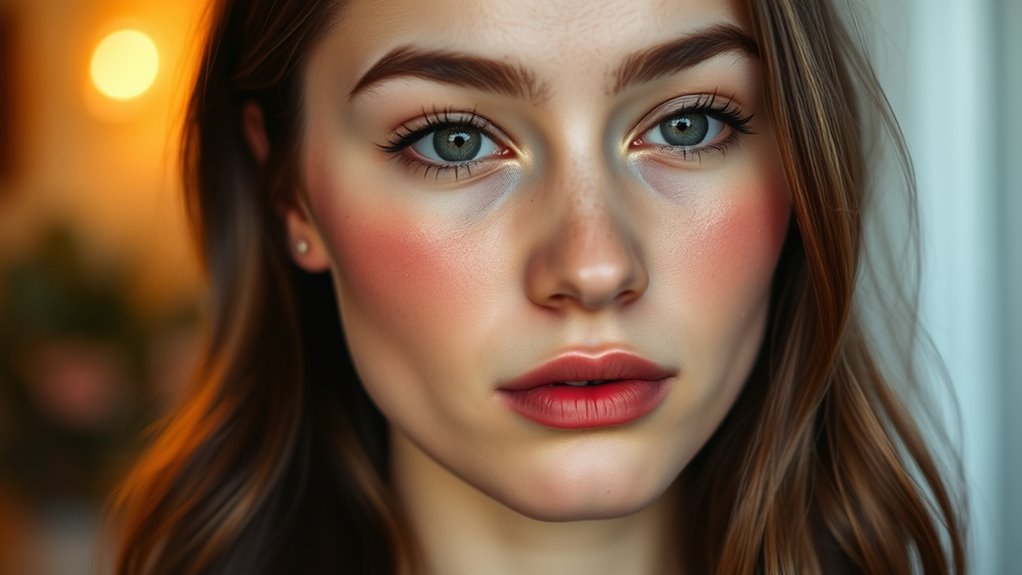Blushing is a natural response triggered by hormonal changes like adrenaline, causing blood vessels in your face to dilate and turn red. This involuntary reaction signals vulnerability and sincerity, making you seem more approachable and trustworthy. When someone notices your blush, it can spark mutual attraction and create a sense of closeness. This subtle nonverbal cue communicates genuine emotion, fostering connection and trust—if you stay with us, you’ll discover even more about how these signals shape attraction.
Key Takeaways
- Blushing results from hormonal reactions that increase blood flow, causing cheeks to turn red involuntarily during emotional states.
- It signals vulnerability and sincerity, making individuals appear more genuine and relatable to others.
- Seeing someone blush can trigger positive social and romantic responses, enhancing mutual attraction.
- Blushing acts as a nonverbal cue of emotional investment, fostering trust and intimacy in social interactions.
- Evolutionarily, it demonstrates honesty and vulnerability, increasing attractiveness and facilitating social bonding.

Blushing is more than just a physical reaction; it’s a subtle signal that can influence attraction. When you blush, your body is sending a powerful message without even realizing it. This involuntary response is often tied to body language cues that others interpret, revealing your genuine emotions. Your cheeks turn red because of increased blood flow triggered by hormonal responses, mainly adrenaline and norepinephrine, which are released when you feel nervous, embarrassed, or attracted to someone. These hormonal responses cause your blood vessels to dilate, especially in the face, resulting in that unmistakable flush.
Blushing signals genuine emotion through hormonal responses and body language cues, enhancing attraction and social connection.
As you stand in front of someone you find appealing, your body unconsciously communicates vulnerability and sincerity through blushing. People are naturally attuned to these subtle body language cues because they serve as honest signals of your emotional state. When you blush, it indicates that you’re emotionally invested, perhaps even embarrassed by your own feelings, which can make you appear more relatable and authentic. This authenticity can enhance your attractiveness because others tend to trust and connect with people who show genuine reactions.
Your blushing also triggers a social feedback loop. When someone notices your blush, they may interpret it as a sign of interest or admiration. This recognition can boost their attraction toward you, often prompting positive social responses. The hormonal responses involved in blushing don’t just affect your face; they can influence your overall demeanor, making you seem more approachable and open. It’s as if your body is saying, “Hey, I’m genuinely interested,” even if you don’t verbally express it. This unintentional display of emotion can profoundly impact how others perceive your attractiveness, creating a sense of vulnerability that many find endearing.
Moreover, the act of blushing can serve as a form of nonverbal communication that reduces social barriers. When you blush, it signals that you’re human, imperfect, and emotionally available. This can foster intimacy and trust, making others feel more comfortable around you. It’s a biological response rooted in evolutionary psychology: showing vulnerability through blushing can increase your chances of forming bonds because it demonstrates honesty and emotional depth.
In essence, your body’s hormonal responses and body language cues work together to turn blushing into a powerful tool of attraction. It’s a natural, involuntary display that communicates your emotional state and invites others to see your genuine self. By understanding how your blush functions on a biological and social level, you can better appreciate the subtle ways your body speaks to others and enhances your chances of forming meaningful connections.
Frequently Asked Questions
Can Blushing Predict Long-Term Relationship Success?
Blushing can hint at long-term relationship success because it’s a powerful emotional signaling and subconscious cue. When you blush around someone you care about, it shows vulnerability and genuine emotion, fostering trust and connection. While not a definitive predictor, consistent blushing indicates deep emotional engagement, which can strengthen bonds over time. So, if you notice yourself blushing frequently around your partner, it might signal a meaningful, lasting connection.
Do Different Cultures Interpret Blushing Differently?
Yes, different cultures interpret blushing differently due to cultural differences in emotional expression. In some societies, blushing is seen as a sign of humility, shyness, or respect, while others may view it as a sign of embarrassment or vulnerability. You should understand that these cultural nuances influence how people perceive and respond to blushing, making it essential to take into account cultural context when interpreting emotional signals across diverse backgrounds.
How Does Blushing Affect Self-Esteem?
Blushing is like a fragile flower opening up, revealing your emotional vulnerability. It can boost your self-esteem when you see it as a sign of honesty and openness, strengthening your body language. However, it might also make you feel exposed, lowering confidence. Embrace it as a natural part of human connection. Recognizing that blushing signals authenticity can help you turn vulnerability into a powerful tool for self-assurance.
Are There Genetic Factors Influencing Blushing Tendencies?
Yes, your genetic predisposition influences how often and intensely you blush. Some people have a natural tendency for stronger blush intensity due to inherited traits, making them more prone to visible redness when embarrassed or shy. These genetic factors affect your skin’s sensitivity and blood vessel response, meaning your blush tendencies are partly shaped by your genes. Understanding this can help you accept your unique reactions and reduce self-consciousness.
Can Technology Detect or Simulate Blushing Responses?
Imagine a camera capturing your face’s subtle shifts—digital detection can now identify blushing responses by analyzing skin tone changes and blood flow. This technology can even simulate emotional responses by mimicking these natural cues, allowing virtual characters to blush authentically. While it’s not perfect, advancements in digital detection and emotional simulation are making it possible to recognize and replicate the complex beauty of human blushes in real-time.
Conclusion
So, next time your cheeks turn red in their presence, remember it’s more than just embarrassment—it’s a secret signal your body sends. Blushing isn’t just a reflex; it’s a powerful dance of chemistry and emotion, revealing your genuine attraction. Like a silent language, it speaks volumes without a word. Embrace it, for sometimes your blush says what words can’t—telling someone you’re truly interested, loud and clear.










